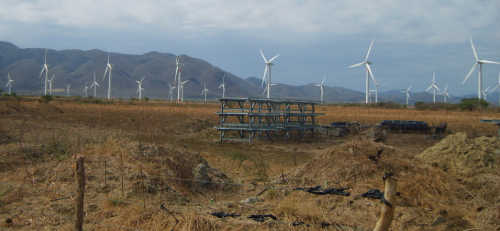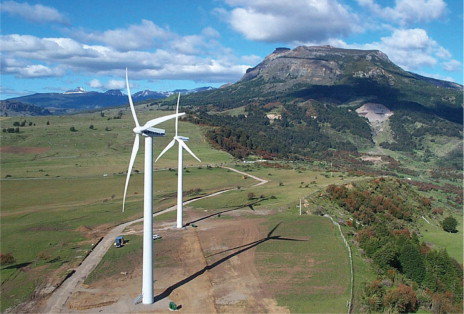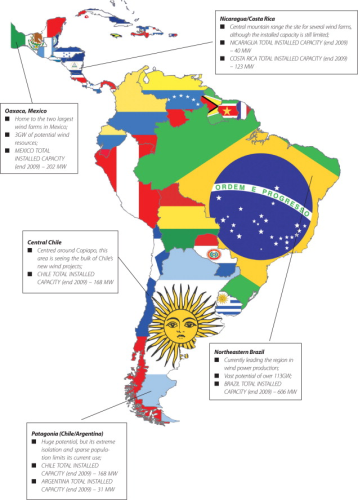


Despite major regional diversity, there appears to be a growing will among Latin American policy makers and business leaders to make countries in the region a much more attractive proposition for renewable energy developers. Wind power in particular has the advantage that it's a good fit for hydropower – Latin America's primary electrical generation method.
So with this in mind, how can the region take further steps forward?
For Ramón Fiestas, president of the Global Wind Energy Council's (GWEC) committee for Latin America, the region is still struggling to find the right framework to promote wind power investments: “Latin America has huge potential but the right regulatory tools and policies still need to be put in place,” he says.
The regulatory framework is anything but congruent, with a wide range of scenarios ranging from state-run monopolies (controlling almost all energy production) to über-free market driven policies that give no breaks for clean technologies.
Is the wind market awakening?
According to the Latin American Wind Energy Association (LAWEA)'s 2009-2010 annual report, the growth in wind power installation gained momentum in 2009, hitting growth rates of 100% – compared to 20% in 2008. And this despite the impact of the global economic crisis. LAWEA credits this growth to a desire by Governments and Regulators to complement hydropower with wind.
GWEC also found 2009 to be a big year for wind power in the region: “While growth in 2009 was still small in absolute terms, with 622 MW installed across the continent, this represented a doubling of the total installed capacity. In addition, the pipeline for new developments is substantial, with numerous large-scale wind farms set to become operational in the coming years,” the Group's annual report reads.
| "...there is still a number of countries that need greater political and economical stability in order for investors to put down the capital necessary to get wind projects off the ground." |
| - Santi Pares, Mateosim Truewind |
Much of the growth comes from Latin American energy regulators that are looking to use renewable energy as a general development plan to boost countries' economies.
For Santi Pares, Commercial Director of wind energy consulting firm Mateosim Truewind, the general state of development needed for energy production in Latin American provides a unique opportunity for wind energy: “In Latin America there are many countries that can grow while adapting their energy needs to use renewable sources,” he believes.
However he also stresses that there are a number of countries that need greater political and economical stability in order for investors to put down the capital necessary to get wind projects off the ground.
Looking forward
According to a study by IHS Emerging Energy Research (EER), Latin America is on the cusp of a larger growth cycle. Over the next 15 years EER predicts a 12.6% compound annual growth of installed wind power, reaching 46 GW as a region by 2025.
EER believes the distribution of wind production in 2025 will reflect its current state: Brazil will lead the region with 31.6 GW of installed capacity, nearly two-thirds of the regional total. Mexico will follow with 6.6 GW.
For the study's principal author, analyst Vincent Gautier, wind energy has been slow to take hold in the region due to a preference for large-scale hydropower projects. Similarly, the high price of wind power equipment has been a limiting factor.
But Gautier believes prices for wind turbines and other components have dropped sufficiently, making wind a more feasible option for energy generation. In addition, unstable weather patterns – namely rainfall, which affects water supply for hydro projects – has nudged wind up the priority list for regulators and investors in Latin America.
Furthermore, despite the impact of the economic crisis on liquidity for lenders, and in turn large wind projects, there has been enough financing available through development banks set aside for Latin America to keep new projects active.
Brazil: The market for wind power
Brazil sits as a regional torchbearer for the potential installed capacity of not just wind energy, but renewable energy sources in general. In fact a 2009 report from the United Nations Environment Program (UNEP) heralded Brazil as the country with the most potential (worldwide) for renewable energy.
While much of this potential is due to the country's expansive landscape and large population, GWEC's Fiestas believes progressive regulatory action and public-private sector co-operation are jointly responsible for the country's leadership in the wind sector.
Also, the Government's decision to use feed-in tariffs has provided investors a stable economic proposition, which is needed to push large wind projects forward.
According to GWEC's annual report, Brazil had 606 MW of wind power installed at the end of 2009 (cumulative), but has a potential 143 GW of power in exploitable resources, mostly in the north-eastern coastal region of the country.
Brazil's wind incentives have taken shape as a result of the 2002 Brazilian Renewable Energy Incentive Program (PROINFA), which established the ground rules for connecting wind farms to the national grid (as well as introducing the FiTs).
Across the country there are a total of 33 operational wind farms, 14 under construction, and a mass of approved projects that have not started construction. These projects together will bring the country's cumulative installed capacity up to 3140 MW.
On an individual level three separate wind farms in the Osorio community of Brazil's Rio Grande do Sul State are the largest producers, representing some 50 MW of installed capacity each – Parque Eólica de Osorio, Parque Eólica Sangradouro and Parque Eólica dos Indios.
Brazil Windpower 2010: timely event in a booming market |
|
Just days after the Brazilian government contracted more than 2,000 MW of wind power, GWEC, ABEEolica and Brazilian media group CanalEnergia hosted Brazil Windpower 2010, the region's first industry-led conference and exhibition. “If you had held this event three years ago, you could probably have fitted it into a van,” joked Brazilian energy minister Marcio Zimmerman during the conference opening session, which was attended by 750 delegates: “But wind power is now a firm component of the Brazilian energy mix, and it is here to stay”. During the three Brazilian wind and renewable energy auctions in December 2009 and August 2010, a total of more than 3,850 MW were contracted, spread across 141 projects. Despite the price achieved by the winning bids, the volume of the contracted capacity coupled with government efforts to create a favourable environment for wind power raise expectations for strong market development. “The Brazilian market is now becoming very attractive for the big global players, and they all want to get in on the ground floor,” said Steve Sawyer, GWEC's Secretary General. “All the ingredients are here for Brazil to grow to a large market very quickly”. The Brazil Windpower 2010 event was attended by 1,836 industry participants from 27 countries, and sponsored by 21 companies, including Eletrobras, Vestas and Wobben Enercon. “We are very pleased with the great interest this event has received in this relatively young market,” said Pedro Perelli, Secretary General of the Brazilian Wind Energy Association (ABEEolica). The Brazil Windpower 2011 conference & exhibition will take place during the first week of September 2011. |
Looking forward, some 1.8 GW were approved through an auction held by the country's energy regulator ANEEL in December 2009, granting licences to 71 new projects.
In addition to installing wind farms, Brazil's position as a mining, technology and manufacturing powerhouse in Latin America makes it a natural choice for turbine manufacturers wanting to bring factories to the country, both for serving the national market and for exporting turbines to other Latin American countries.
In the last three years several large wind equipment manufacturers, have chosen Brazil as a location to install new turbine and blade factories. Wobben Wind Power has manufactured turbines in Brazil since 1994, and new players such as IMPSA Wind, TECSIS, Suzlon and Vestas have all started manufacturing – both for local PROINFA projects as well as for export.
The EER study also cited Brazil as the probable Latin American location of choice for wind turbine manufacturing. This would put the country in line to receive a large share of the market, which is expected to grow from just under US$1 billion in 2009 to more than US$2.2bn by 2015.
Mexico
Having the second-largest population in Latin America, Mexico is also a natural industrial leader, and a wind development scenario similar to Brazil's is feasible. But the country is still taking its first steps towards a more dynamic and broad wind production layout, with most of today's activity focused in the state of Oaxaca, along the southern coast of the country.
According to LAWEA, Oaxaca has a potential of more than 3 GW of wind energy. Today the state is home to two of the country's three functioning wind parks: La Venta I and La Venta II. La Venta I was constructed in 1994, and has a capacity of nearly 9 MW, while the La Venta II project brought 84 MW online at the end of 2008.
The Mexican Government has taken a different approach towards encouraging projects, choosing to directly subsidise studies (and construction) once they have been successfully completed. The regulatory framework to encourage renewable energy generation is still relatively new, with a first bill passed in 2008 – which only took effect in 2009.
Due to its status as an outsourcing and manufacturing centre for US companies, Mexico also has potential as an industrial production centre for wind turbines and equipment. However, according to the LAWEA, this industry is still in its infancy, though interest in Mexico from international wind equipment manufacturers is growing. For example, US manufacturer Clipper Windpower sources a “considerable amount” of magnet electrical generators for its 2.5 MW turbines from Mexican manufacturer Potencia Industrial.
Chile
With a population of nearly 16 million, and over 4000 km of coastline, the narrow country of Chile offers a unique scenario for wind energy. According to GWEC, Chile already has 168 MW of installed capacity, 148 MW of that added in 2009. For renewable energy in general the biggest obstacle has been the country's dedication to free market principles i.e. that any new energy generation must compete using the same regulatory framework as conventional sources, and that the market must make (or break) any new technology or energy source.
But Chile produces only a tiny fraction of the energy needed to supply its consumption. Unstable fuel prices and rainfall paired with natural gas cuts from neighbouring Argentina have forced Chilean officials to rethink their energy strategy.
In order to stimulate more electrical energy production, two tranches of legislation were passed in 2004, which have opened the door for renewable power generators to connect to the national grid.
Apart from the 168 MW of wind power, another large wind project, the Talinay Wind Park, is scheduled to bring 125 MW of installed power in 2012. These projects are focused in the northern central region of the country, near the city of Copiapo.
The extreme south – Patagonia – remains an area with enormous potential if interconnection issues can bridge the rugged and isolated landscape. The far north of the country, the Atacama Desert, could also be a location for wind projects that feed directly into the copper mining industry, a trend already present for geothermal and, to some degree, solar energy.
Costa Rica
Costa Rica is another example, like Chile, of a small country where wind power could be used to complement limited production capacity.
Currently Costa Rica receives some 79% of its power from large hydro power projects. In terms of its electrical production market, the landscape is dominated by the state run monopoly, ICE, and only 15% of power may be legally generated by private firms. This landscape creates a more restrictive environment for private wind farms.
For its part ICE has identified the central volcanic mountain range as being an area potentially rich in wind resource, estimating in one of its studies that 600 MW of wind energy could be profitably exploited.
| "According to a study by IHS EER, Latin America is on the cusp of a larger growth cycle. Over the next 15 years EER predicts a 12.6% compound annual growth of installed wind power - reaching 46 GW as a region by 2025. |
Currently the country has 123 MW of installed capacity, and a total of four farms. A fifth farm is also being constructed by ICE in Guenacaste. This farm is due at the end of year and will have an installed capacity of 49.5 MW.
Although moving wind energy forward in the country will be complicated due to the country's monopoly structure, Costa Rica could have potential as a production centre for turbine and turbine supply equipment. According to LAWEA, Costa Rica's educated population, favourable investment climate, not to mention its political and economic stability, all make the country a possible future destination for companies that fabricate components – not to mention the turbine manufacturers themselves.
Nicaragua
Nicaragua is the newcomer to Latin America's wind power industry. With 40 MW of installed power inaugurated in April 2009 – in Amayo – wind generation provides a greater share of the 863 MW of total installed electrical capacity in the country than any other country in Latin America.
Another 215 MW of wind power projects are in different planning stages, but according to LAWAE, the low base electricity demand in the country (300 MW average) complicates how these projects will be used.
The most likely scenario is that they must wait until the Central American Electrical Interconnection System (SIEPEC) is online. SIEPEC will connect Guatemala through Panama along a 300 MW transmission line. The project was slated for 2009, but is still awaiting completion.
About the author:
Colin Bennett is based in Santiago, Chile, and is Renewable Energy Focus' Latin America correspondent.
This article first appeared in Renewable Energy Focus, Volume 11, Issue 5, September-October 2010.



